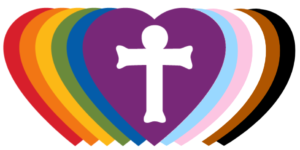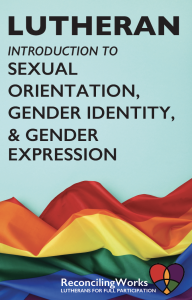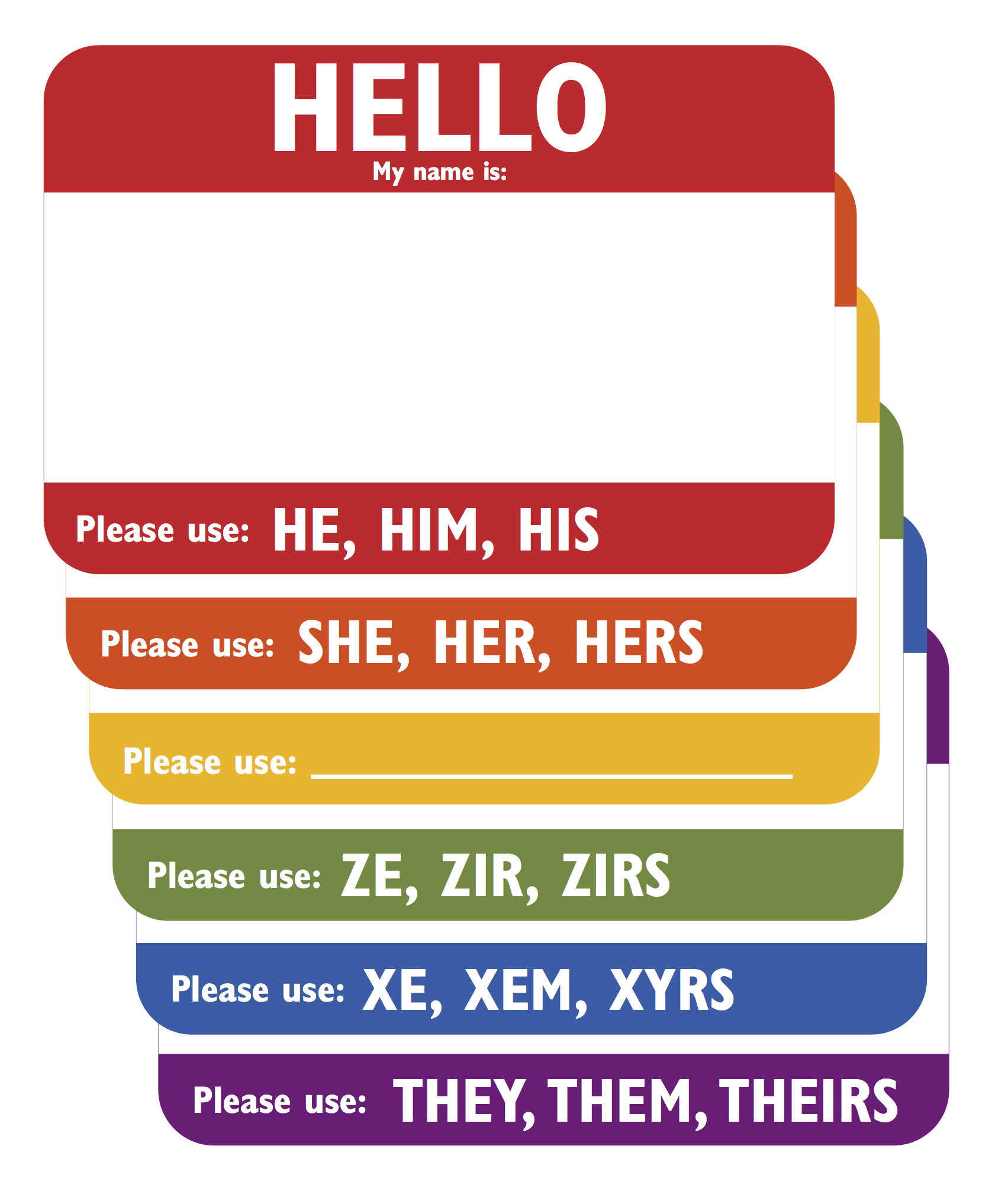Lutheran Introduction to Sexual Orientation, Gender Identity, & Gender Expression
(The print version of this resource is available for purchase from our eStore.)
Since 1974, ReconcilingWorks: Lutherans for Full Participation has advocated for the full welcome, inclusion, and equity of lesbian, gay, bisexual, transgender, queer, intersex, and asexual/aromantic (LGBTQIA+) Lutherans in all aspects of the life of their Church, congregations, and community. The Reconciling in Christ (RIC) Program of ReconcilingWorks is for congregations, synods, colleges, seminaries, and other Lutheran organizations that publicly welcome LGBTQIA+ people.
As a way to deepen and expand that welcome, we offer this resource as a basic introduction to sexual orientation, gender identity, and gender expression. Here are a few helpful tips on how to use this resource:
WHY SHOULD WE SINGLE OUT LGBTQIA+ PEOPLE?
Many LGBTQIA+ people have learned by experience that they are not truly welcome in church, even in churches that state, “All are welcome here!” A general statement of welcome is often heard as meaning “everybody but me,” so it can take a special effort to communicate an authentic welcome to LGBTQIA+ people. The RIC program seeks to make known settings where people of all sexual orientations, gender identities, and gender expressions are truly welcomed.
Visit the RIC tab on the website for more info.
1. PEOPLE OVER DEFINITIONS
If you don’t know which identity terms, pronouns or titles to use, and find yourself getting “stuck” on terms, re-center yourself on the fact you are talking about a person. It is also ok to ask which pronouns one prefers, or just avoid using gendered terms. Remember, all you need to welcome someone is their name.
2. CURIOSITY CONTINUUM
This resource teaches sexual orientation, gender identity, and gender expression continua. However, the curiosity continuum is equally important as we seek to extend welcome to our LGBTQIA+ neighbors.
HOSPITABLE CURIOSITY
LURID CURIOSITY
When getting to know someone or learning more about a people group, you are sure to have many questions. Before you inquire, ask yourself “Why am I asking?” or “Will this question help build a relationship of mutual trust and respect?” Does your question represent hospitable or lurid curiosity? Asking people about the details of their bodies is not hospitable. The goal of this resource is to dismantle barriers between people, and the perception that LGBTQIA+ people are exotic oddities does not serve that goal.
3. SELF CARE
The SOGIE (sexual orientation, gender identity, and gender expression) spectrum is a place where hopefully all people can find their reflection. But if you can not find yourself don’t worry. Some identify off the spectrum. Some also experience a new awareness of themselves or loved ones, and it is important to practice self-care as someone continues in their learning.
SOGIE SPECTRUM
Sexual Orientation, Gender Identity, and Gender Expression
At the moment someone gives birth, there is a new-born, a doctor, and a question: “Is it a girl or a boy?” Most State Birth Certificates only have two boxes, and only one can be checked. This is an example of the gender binary system, where there are two, and only two, very distinct options. It is one or the other, male or female. And the way that question is answered has ramifications throughout one’s entire life. Future options, expectations, and opportunities all hinge on which box is checked. And interestingly, notice that the very question – “Is it...?” – withholds personhood until a gender is assigned.
Sex, gender identity, and gender expression can be experienced on a continuum, creating a nearly infinite combination of identities. The binary gender system says that there are only two genders. Here, we can see that gender is truly far more complex this binary system.
SEX
⬚ Female
Intersex
Male ⬚
SEX is assigned at birth based on external genitalia, reproductive organs, chromosomes, and hormones. People with ambiguous genitalia or other biological complexities (such as an unusual chromosomal pattern or hormonal shifts) may identify as intersex.
GENDER IDENTITY
Woman
Genderqueer
Man
GENDER IDENTITY refers to a person’s innate, deeply felt psychological identification as a man, woman or another gender, which may or may not correspond to the sex assigned to them at birth. Gender identity is different from the term “gender”, which is typically used with reference to social and cultural differences rather than biological ones.
GENDER EXPRESSION
Feminine
Androgynous
Masculine
GENDER EXPRESSION refers to the external characteristics and behaviors that are socially defined as either masculine or feminine, such as dress, grooming, mannerisms, speech patterns and social interactions. These norms vary culturally.
SEXUAL ORIENTATION
Attracted to Men
Bisexual, Pansexual, Queer
Attracted to Women
SEXUAL ORIENTATION is the term used to describe what gender(s) someone is physically and/or emotionally attracted to. Lesbian, gay, bisexual, pansexual, queer, and straight are all examples of sexual orientations. A person’s sexual orientation is distinct from a person’s gender identity and expression.
Our lives are more complex than checkboxes. These continua are an important reminder of putting people over definitions and practicing our Lutheran tradition of practicing hospitality and welcoming our neighbors.
BISEXUALITY
[Not straight. Not gay.]
BISEXUAL is an identity term people use when they are physically and/or emotionally attracted to people of all gender identities. Some people prefer to use the terms pansexual or queer because bisexual has the connotation of “binary” with the “bi” language, although this was not the intention when the term was created for the community.
BI* (with the asterisk) is an umbrella term to encompass bisexual, pansexual, queer, and other sexual orientations that are used to describe attraction to more than one gender identity.

SEXUAL ORIENTATION: is the term used to describe what e gender(s) someone is physically and/or emotionally attracted to. Lesbian, gay, bisexual, pansexual, queer, and straight are all examples of sexual orientations. A person’s sexual orientation is distinct from a person’s gender identity and expression.
PEOPLE OVER DEFINITIONS:
Sexual orientation isn’t contingent on being in any given relationship. It is about honoring a core and authentic part of oneself. Bisexual people are told by some heterosexual people, and even some gay and lesbian people, that they must choose to be heterosexual or gay/lesbian. Such messages reflect an inaccurate understanding of bisexuality. Bi* identities are authentic and should be honored and supported as with heterosexual and gay/lesbian.
TRANSGENDER & GENDER NON-CONFORMING
[Not cisgender.]
TRANSGENDER is an identity many people use whose self-experienced gender does not match the sex they were assigned at birth. For example, a transgender person might be someone who identifies and lives as a woman but whose birth-assigned sex was male. Other transgender people identify as somewhere in between the societally recognized genders of man and woman, as neither, or as one gender at some times and another gender at other times.
TRANS can be an umbrella term used to refer to transgender, genderqueer, non-binary, and gender non-conforming people. The colors of the transgender flag are incorporated in this graphic.

GENDER NON-CONFORMING people who hold gender identities that are the same as their birth-assigned sex, but do not express their gender identity in ways that conform to societal and/or cultural expectations.
GENDERQUEER can describe a person who does not subscribe to conventional gender distinctions but identifies with neither, both, or a combination of male and female genders.
CISGENDER describes a person whose birth-assigned sex and gender identity are the same. For example, a person whose assigned sex is female and who identifies as a woman is cisgender.
PEOPLE OVER DEFINITIONS:
When someone shares their identity, honor that self-understanding by using the words, pronouns, and identity terms they provide.
QUEER
[Not queer as in a slur, but queer as in someone’s identity.]
HISTORY OF TERM: In the late 1980s, the label “queer” began to be reclaimed by LGBTQ people as a positive self-identifier. The term has also been reclaimed as an adjective to describe something in the LGBTQ community that disrupts societal norms: queer bodies, queer art, queer theology.
QUEER can be an umbrella term for the LGBTQ community. It can also refer to an individual’s sexual orientation and/or gender identity. It is an identifier for all non-heterosexual orientations and non-cisgender identities. The colors of the LGBTQ flag are incorporated in this graphic.

WHY USE QUEER? People choose to use queer instead of lesbian, gay, bisexual, or transgender for a variety of reasons. Some people choose this term for themselves because they feel like they do not fit into the roles other labels imply. For some it can also mean they do not fit into societal norms and want an identity term to reflect who they really are.
PEOPLE OVER DEFINITIONS:
Some people prefer not to be grouped under this term or not have non- queer people use it when referring to them. Please use caution as you use the term to describe someone. Not all queer people use he/him/his or she/her/hers pronouns. For some “they, them, theirs,” “xe, xem, xyrs,” or “ze, hir, hirs” are gender inclusive pronouns which most accurately reflect that person’s identity. Read more about personal pronouns below.
Personal Pronouns
Personal pronouns are the set of pronouns a person wants others to use when talking to or about them. Understanding there is a difference between a person's sex, gender identity, and gender expressions makes the use of pronouns important. Asking someone "What pronouns do you use?" is a great way to hospitably see, name, and care for LGBTQIA+ people.
Here are a few helpful ways to use pronouns
- Ask people what their pronouns are when you meet them. “I want to make sure I am using the proper pronouns for you, which pronoun do you use?”
- Add them to the signature of your emails.
- Make space for people to add their pronouns to name tags for events and gatherings.
- If you make a mistake and someone corrects you, thank them for teaching you their personal pronouns.
Looking for a template for incorporating pronouns into your name tags? Check out ReconcilingWorks Name Tag and Pronoun Template HERE!
Intentional welcome to all people and families matters. As Lutherans, we believe every human being reflects the Divine image. Each of us is a beloved child of God, wonderfully made, just as we are. Our confidence in Christ Jesus calls us to work with all God’s people to transform our communities, so welcome can be a lived experience in our congregations and in the world.
 The print version of this resource is available for $2.25 from our eStore.
The print version of this resource is available for $2.25 from our eStore.
For more information about this resource or about how you can partner with ReconcilingWorks contact us at:
PO Box 8070, Saint Paul, MN 55108
P: 651-665-0861
info@ReconcilingWorks.org

